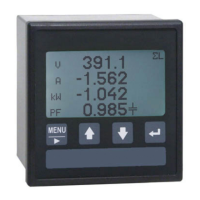3-3
ENGLISH
Description
MODBUS protocol manual
3.1 LRC generation
The Longitudinal Redundancy Check (LRC) field is one byte, containing an 8–bit binary value.
The LRC value is calculated by the transmitting device, which appends the LRC to the message.
The receiving device recalculates an LRC during receipt of the message, and compares the
calculated value to the actual value it received in the LRC field. If the two values are not
equal, an error results. The LRC is calculated by adding together successive 8–bit bytes in
the message, discarding any carries, and then two’s complementing the result. The LRC is an
8–bit field, therefore each new addition of a character that would result in a value higher than
255 decimal simply ‘rolls over’ the field’s value through zero. Because there is no ninth bit, the
carry is discarded automatically.
A procedure for generating an LRC is:
1. Add all bytes in the message, excluding the starting ‘colon’ and ending CR LF. Add them
into an 8–bit field, so that carries will be discarded.
2. Subtract the final field value from $FF, to produce the ones–complement.
3. Add 1 to produce the twos–complement.
PLACING THE LRC INTO THE MESSAGE
When the the 8–bit LRC (2 ASCII characters) is transmitted in the message, the high–order
character will be transmitted first, followed by the low–order character. For example, if the
LRC value is $52 (0101 0010):
Colon
‘:’
Addr Func Data
Count
Data Data …. Data LRC
Hi ‘5’
LRC
Lo‘2’
CR LF
C-function calculate LRC
*pucFrame – pointer on “Addr” of message
usLen – length message from “Addr” to end “Data”
UCHAR prvucMBLRC( UCHAR * pucFrame, USHORT usLen )
{
UCHAR ucLRC = 0; /* LRC char initialized */
while( usLen-- )
{
ucLRC += *pucFrame++; /* Add buffer byte without carry */
}
/* Return twos complement */
ucLRC = ( UCHAR ) ( -( ( CHAR ) ucLRC ) );
return ucLRC;
}

